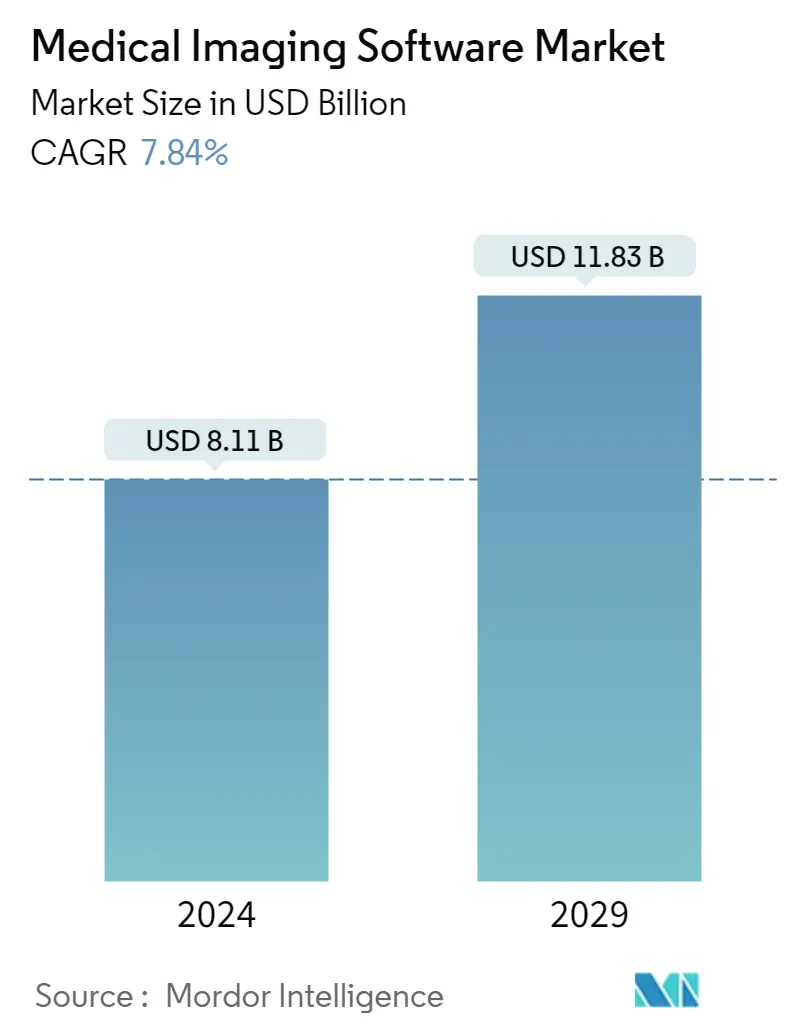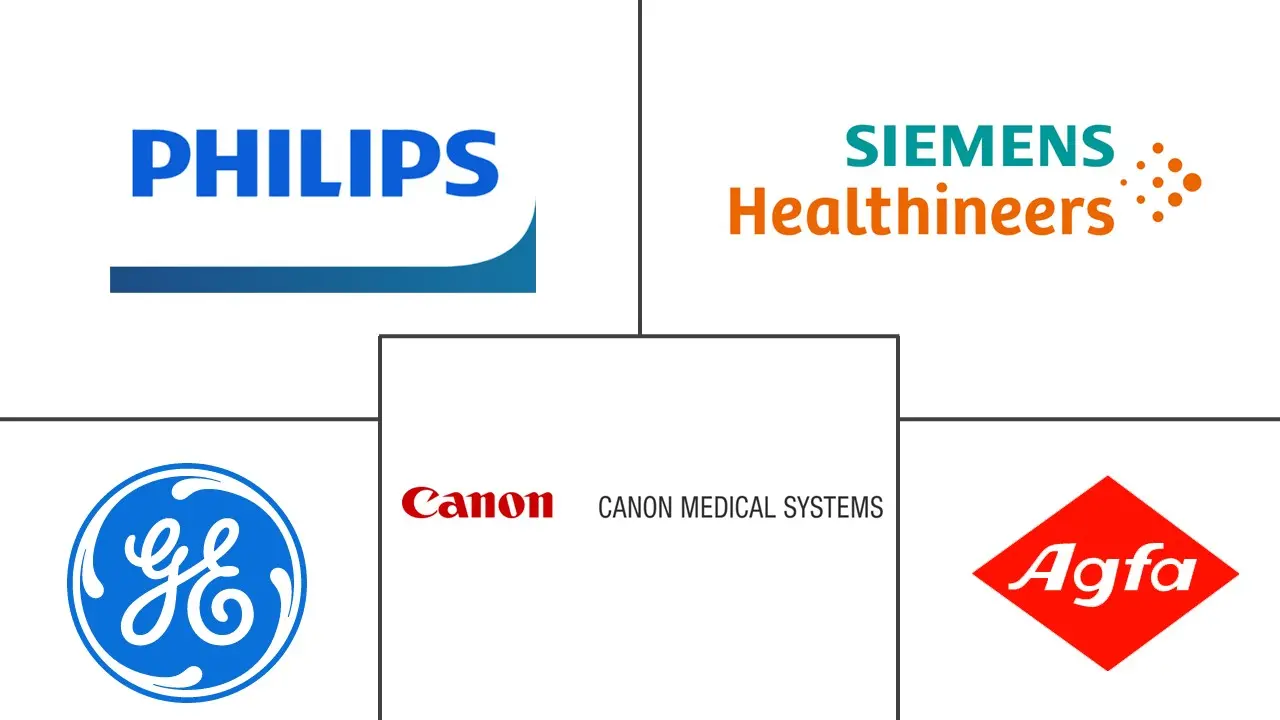Market Size of Medical Imaging Software Industry

| Study Period | 2019 - 2029 |
| Market Size (2024) | USD 8.11 Billion |
| Market Size (2029) | USD 11.83 Billion |
| CAGR (2024 - 2029) | 7.84 % |
| Fastest Growing Market | Asia Pacific |
| Largest Market | North America |
| Market Concentration | Low |
Major Players
*Disclaimer: Major Players sorted in no particular order |
Medical Imaging Software Market Analysis
The Medical Imaging Software Market size is estimated at USD 8.11 billion in 2024, and is expected to reach USD 11.83 billion by 2029, growing at a CAGR of 7.84% during the forecast period (2024-2029).
Machine learning and artificial intelligence have attracted the healthcare industry as these innovative analytics strategies have become more accurate and precise.
- The need for medical imaging software for advanced treatment for people with arthritis, cancer, etc., demands an advanced version. This advanced image is used to advance patient care and improve operating productivity by empowering doctors and other healthcare professionals by providing more details about patient conditions.
- An increase in demand for diagnostic imaging software in applications such as dental, Orthopedic, Cardiology, obstetrics and gynecology, Mammography, urology, and neurology, is expected to contribute to the market growth.
- The increasing use of ultrasonic imaging equipment for earlier diagnosis, particularly chronic disorders, is likely to drive the market's demand. Furthermore, ongoing advancements in imaging technologies, such as Computer-aided Diagnosis (CAD), are expected to boost demand for these systems. The adoption of Artificial Intelligence (AI) in medical imaging has transformed market trends in recent years and is expected to impact future growth positively.
- The high cost of imaging equipment, combined with the increased implementation and licensing fees of software, is the biggest constraint to market expansion, particularly in countries with poor reimbursement scenarios. For example, most healthcare facilities in developing nations, such as hospitals and diagnostic centers, have costs.
- During the COVID-19 pandemic, various AI, machine learning, and deep learning technologies were applied in medical image processing, which will drive market expansion further. Because of the increasing demand for efficient solutions for better patient outcomes, diagnostic and research institutes are expected to emerge as significant end users of image analysis solutions. Due to the technological advancements in medical applications, the market is increasing after the pandemic.
Medical Imaging Software Industry Segmentation
Medical imaging is a part of healthcare practices across the globe that uses the latest technological advancements, software, and equipment to generate graphical representations of the interior of a body for diagnosis, clinical analysis, and medical intervention. The growing demand for healthcare services for the aging population significantly impacts the healthcare industry's growth. It is supported by medical advances and improvements in medicine and technology, affecting the demand for healthcare services. The advancement of 3D/4D platforms and multimodality imaging platforms are acting as catalysts for this market.
The market is segmented by Imaging Type (2D Imaging, 3D imaging, and 4D imaging), by Application (Dental Applications, Orthopedic Applications, Cardiology Applications, Obstetrics and Gynecology Applications, Mammography Applications and Urology and Nephrology Applications), and by Geography. The market sizes and forecasts are provided in terms of value (USD million) for all the above segments.
| By Imaging Type | |
| 2D Imaging | |
| 3D Imaging | |
| 4D Imaging |
| By Application | |
| Dental Applications | |
| Orthopaedic Applications | |
| Cardiology Applications | |
| Obstetrics and Gynaecology Applications | |
| Mammography Applications | |
| Urology and Nephrology Applications | |
| Other Applications |
| Geography | ||||||
| ||||||
| ||||||
| ||||||
|
Medical Imaging Software Market Size Summary
The medical imaging software market is poised for significant growth, driven by advancements in machine learning and artificial intelligence, which have enhanced the accuracy and precision of diagnostic tools. This growth is fueled by the increasing demand for advanced imaging solutions in various medical fields, including cardiology, oncology, and neurology, to improve patient care and operational efficiency. The adoption of ultrasonic imaging and computer-aided diagnosis technologies is further propelling market expansion. However, the high cost of imaging equipment and software licensing fees pose challenges, particularly in regions with limited reimbursement options. The COVID-19 pandemic has accelerated the integration of AI and machine learning in medical imaging, highlighting the need for efficient solutions to improve patient outcomes.
North America is expected to lead the global market, supported by substantial investments in medical infrastructure and a robust presence of healthcare IT firms. The region's well-established healthcare institutions and favorable government policies are conducive to the adoption of advanced imaging technologies. Key players in the market, such as GE Healthcare, Philips, and Siemens, are focusing on research and development, strategic partnerships, and product innovations to maintain competitive advantages. The market is characterized by high competitive rivalry, with companies expanding their product portfolios and exploring vendor-neutral archive technologies to enhance interoperability and integration with electronic health record systems. As the prevalence of chronic diseases rises, the demand for medical imaging software continues to grow, driving further advancements and market expansion.
Medical Imaging Software Market Size - Table of Contents
-
1. MARKET INSIGHTS
-
1.1 Market Overview
-
1.2 Industry Value Chain Analysis
-
1.3 Industry Attractiveness - Porter's Five Forces Analysis
-
1.3.1 Threat of New Entrants
-
1.3.2 Bargaining Power of Buyers
-
1.3.3 Bargaining Power of Suppliers
-
1.3.4 Threat of Substitute Products
-
1.3.5 Intensity of Competitive Rivalry
-
-
1.4 Assessment of Impact of COVID-19 on the Market
-
-
2. MARKET SEGMENTATION
-
2.1 By Imaging Type
-
2.1.1 2D Imaging
-
2.1.2 3D Imaging
-
2.1.3 4D Imaging
-
-
2.2 By Application
-
2.2.1 Dental Applications
-
2.2.2 Orthopaedic Applications
-
2.2.3 Cardiology Applications
-
2.2.4 Obstetrics and Gynaecology Applications
-
2.2.5 Mammography Applications
-
2.2.6 Urology and Nephrology Applications
-
2.2.7 Other Applications
-
-
2.3 Geography
-
2.3.1 North America
-
2.3.1.1 United States
-
2.3.1.2 Canada
-
-
2.3.2 Europe
-
2.3.2.1 Germany
-
2.3.2.2 France
-
2.3.2.3 United Kingdom
-
2.3.2.4 Rest of Europe
-
-
2.3.3 Asia-Pacific
-
2.3.3.1 China
-
2.3.3.2 Japan
-
2.3.3.3 India
-
2.3.3.4 Rest of Asia-Pacific
-
-
2.3.4 Rest of the World
-
2.3.4.1 Latin America
-
2.3.4.2 Middle-East & Africa
-
-
-
Medical Imaging Software Market Size FAQs
How big is the Medical Imaging Software Market?
The Medical Imaging Software Market size is expected to reach USD 8.11 billion in 2024 and grow at a CAGR of 7.84% to reach USD 11.83 billion by 2029.
What is the current Medical Imaging Software Market size?
In 2024, the Medical Imaging Software Market size is expected to reach USD 8.11 billion.

